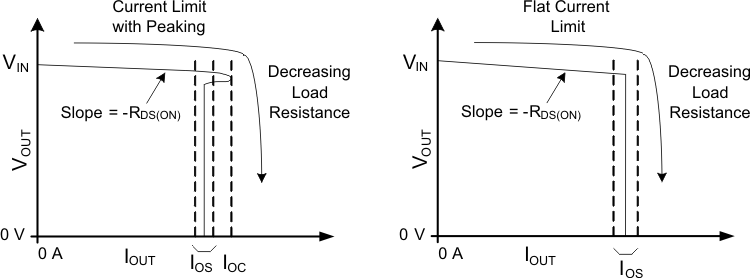SLVS798G January 2008 – June 2024 TPS2062A , TPS2066A
PRODUCTION DATA
- 1
- 1 Features
- 2 Applications
- 3 Description
- 4 Pin Configuration and Functions
- 5 Specifications
- 6 Parameter Measurement Information
- 7 Detailed Description
- 8 Application Information
- 9 Device and Documentation Support
- 10Revision History
- 11Mechanical, Packaging, and Orderable Information
Package Options
Mechanical Data (Package|Pins)
Thermal pad, mechanical data (Package|Pins)
- DRB|8
Orderable Information
7.3 Overcurrent
A sense FET is employed to check for overcurrent conditions. Unlike current-sense resistors, sense FETs do not increase the series resistance of the current path. When an overcurrent condition is detected, the device maintains a constant output current and reduces the output voltage accordingly. Complete shutdown occurs only if the fault is present long enough to activate thermal limiting.
There are two kinds of current limit profiles for the TPS206xA devices.
The TPS2062ADRB, TPS2066ADRB, and TPS2066AD have an output I vs V characteristic similar to the plot labeled Current Limit with Peaking in Figure 7-1. This type of limiting can be characterized by two parameters, the overcurrent trip threshold (IOC), and the short-circuit output current threshold (IOS).
The TPS2062AD has an output I vs V characteristic similar to the plot labeled Flat Current Limit in Figure 7-1. This type of limiting can be characterized by one parameters, the short circuit current (IOS).
 Figure 7-1 Current Limit Profiles
Figure 7-1 Current Limit Profiles